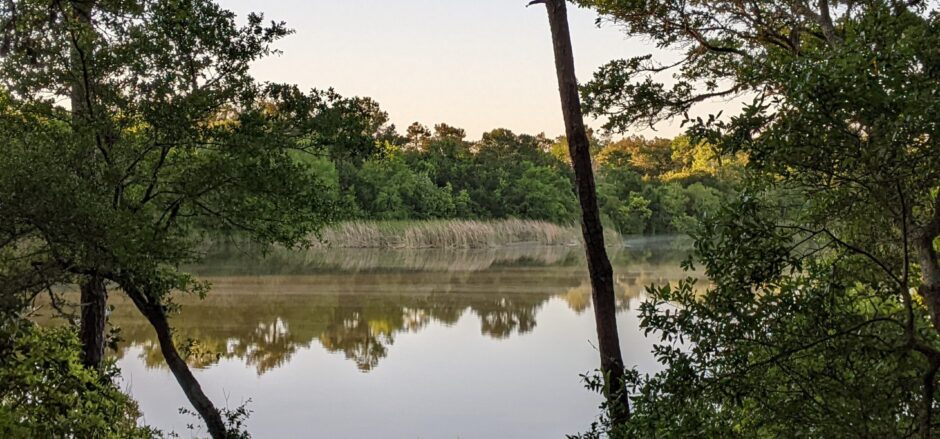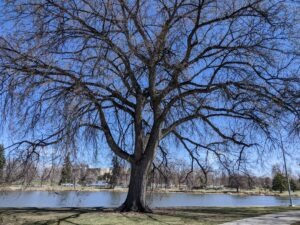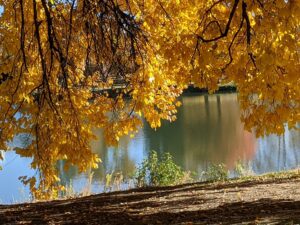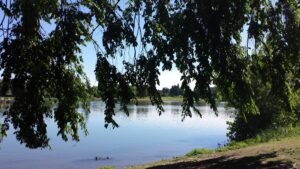Trees are sanctuaries, said Herman Hesse and probably a lot of other people. When I was thirteen, we stopped mobile living and bought a house with a small wood behind it that was perfectly timed for the onslaught of adolescence. I fled to those trees—Florida pine, hickory, and scrub palm, for solace, for solitude. Trees have a calming effect.
An American Elm grew at the edge of the alley when we bought our Denver house. It had never been cared for, had forked into two large trunks, one of them slanted sharply. Still, the arborist said it was the healthiest elm he’d seen in a long time. We treated and trimmed it for years. Once a contractor came through the alley, cutting branches away from power lines, and offered to take out the tree altogether. “Why?” I asked. “Because it’s an elm,” he replied. I declined.
Dutch Elm disease decimated the American Elm throughout the country. There were about 200,000 of them in Denver and around 3,800 were left when the Dutch Elm pandemic ended in the 1980s. Those that did best were isolated from others of their kind, as ours was. Perhaps there’s a lesson in that? An early autumn snowstorm when the elm was in full yellowing leaf brought down enough of it that the rest couldn’t be saved. I miss the shelter it provided from the alley, the shade it gave the yard.
City Park has one of my favorite elms. No other trees are nearby so it was able to grow the vase-like way elms prefer to grow, its branches high and wide and bowing toward the ground like willows. I heard elms were related to willows, because of that dipping, but my cursory research indicates they are not. Elms have a tribe of their own, the Ulmaceae. The American Elm can live more than 200 years.
Created on the rolling hills of treeless plains, City Park was a place of prairie grasses, where bison grazed. Native trees, like cottonwood and hackberry, hugged creeks. The likes of blue spruce and aspen were happier higher and cooler than here. My Denver neighborhood, on the eastern side of the city, was part of that treeless plain. Our Victorian house sits in the middle of the three-block gentle downslope of one of its long hills.
The park was established in 1882, fed with the manmade Denver Ditch and planted with all manner of trees, native and imported. City Park now has over 3,000 trees representing hundreds of species. The Wych Elm, purportedly grown from a scion of a tree by Shakespeare’s grave, was planted in 1916, on the day of The Bard’s death 300 years before. That tree survived Dutch Elm disease and vandalism and looks its age. There’s a Lilac row, a crabapple collection, the Yoshima Cherry Groves and any number of American Elms, native to the Eastern U.S.
My favorite, rooted by Ferril Lake, is nearly perfect in my view. A tree planted by the water will thrive. Like a tree planted by the water, we shall not be moved. A line from the Bible. A song once sung on picket lines. I walk City Park often, have photographed this elm in all seasons over decades, my eye particularly fond of the cascading fall of its full leaf branches over a view of the lake. I suppose it must be well over 100 by now.
The ill-chosen maple we planted on our parking strip died a few years ago of drought and heat, despite the sprinkler system. This year I applied and have been approved for another tree on the parking strip. The tree lawn, some call it. Our new tree will be a Prairie Stature oak, more tolerant of our increasingly hot, dry summers and cold hardy as well.
We have aged into the last quarter of our lives, the last quarter of being stewards of this house and yard. Like the elm, oaks are slow-growing trees. If it survives our changing climate, this one won’t reach full size before we’re gone. We’ll plant it in an act of blind faith, for children not yet born.



